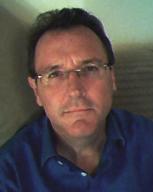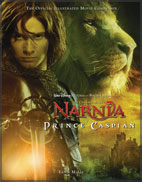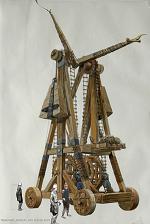 You may remember that, in our first interview with Prince Caspian Art Director Frank Walsh, there were some memories of his experience on set that he wanted to save for another time.
You may remember that, in our first interview with Prince Caspian Art Director Frank Walsh, there were some memories of his experience on set that he wanted to save for another time.
Now, that time has come to share with you all these amazing behind-the-scenes stories that make us realize today’s animation is not only about making animated features and shorts, but also that the present and the future of this art is in its co-operation with all the exciting disciplines at work in filmmaking. Frank Walsh’s position in the process, at its core, made him the perfect expert to tell us about that, and he has several stories to share with us!
So, let’s begin with some aspects that may be taken for granted on screen, but that prove to be highly characteristic of state-of-the-art visual effects filmmaking: the Telmarines’ weapons in Prince Caspian‘s final battle. As you shall see, there’s more than meets the eye!
Animated Views: So, Frank, what behind-the-scenes story would you like to share today?
Frank Walsh: In regard to your question previously about memorable set challenges, one that encompassed the whole gamut of filmmaking disciplines was the issue of the Telmarine Armies War Weapons, seen in the final battles against the Narnians. To resolve the challenge, they required design, visual effects, special effects, construction, set decoration and location co-operation to be achieved.
AV: What were the ambitions of the sequence from that point of view?
FW: As I explained earlier, pre-viz undertook a lot of work early on, based on very rudimentary concepts. When I joined, the animatic of the final battle outside the How had been set out, and key components were items such as the Trebuchets (mechanisms that throw heavy rocks) and the Ballistas (arrow firing weapons). Although these weapons date from antiquity, and there are many historical references to follow, Andrew wanted them to be radically different. So in the pre-viz, they look very traditional in design, but in action he wanted them to be rapid multiple firing mechanisms.
AV: It sounds like it was a huge collaborative effort!
FW: To digress very briefly, back to the problems faced by finding the right art department crew members. When I initially select crew I have to consider how the art department supports the main, 2nd, and visual effects shooting units. With the main unit, it was relatively easy, as in New Zealand, with shooting split between the North and South Islands, each of the three art directors stood by on the set that they had created. In Europe however, because we had a Czech standby crew, I decided to use a dedicated Czech art director, appointed to monitor the day to day needs of the unit. This was because so much work was studio based, I could more easily support them directly as required on an ad hoc basis. However when the unit moved away to far flung locations, I adopted the system of an experienced art director monitoring the situation more closely.
However, due to the story, I realised that the 2nd unit would pose much more complicated challenges by the nature of what they were expected to do. And due to the fact that the Weapons of War would be utilised far more by that unit, felt I needed someone experienced enough to both oversee the creation of the weapons, and monitor their deployment, along with all the other gamut of challenges posed by this unit. If any art director was going to design them, I knew they would be the best person to make responsible for ensuring the logistics were also addressed. No use having a great design if the wheels keep coming off!
Jason Knox-Johnston was my nominated art director for this role, due to his knowledge as a set designer, his experience working in complex standby situations, his technical problem solving skills, and his earlier experience working for me on standby with Gerd Freuchter, the SFX supervisor on Caspian (his previous film was Buffalo Soldiers). An essentially prerequisite I felt in this instance to maintain a close comfortable working relationship with critical partners.
AV: First, how did you conceive the Trebuchets?
FW: We analysed the animatic, and taking Andrew [director Adamson]’s request for the rapid firing capability, went essentially back to the drawing board. The basic concept of such a weapon is a single arm, pulled back under tension, that when released, launches a single heavy object, before having to be brought back and reloaded. What Andrew wanted was a way of loading the projectiles and launching them one after another as a continuous barrage.
After much head scratching and rejected ideas, it became apparent that to have some logic, the only way to effectively achieve this was to build a rotating arm Trebuchet, which operated much akin to a windmill action, a continuous revolving arm, being automatically rearmed on each rotation. Andrew and Roger like the idea, and decided that one arm wasn’t enough, so the multi arm solution was arrived at. Jason developed the ideas utilising Auto Cad, which allowed us to not only design an engineered solution, but easily animate the object to help Andrew and Roger resolve the concept problems. Minor issues such as how it would have worked in reality had to then be solved, so a believable visual solution was presented. Much had to be made with the idea of continuous chains, driven by a large cogged wheel by toiling soldiers.
AV: How did you solve these technical issues?
FW: Due to the fact that the machines having been built would have to travel by public road to the far flung locations, and the scenes required them to be seen appearing from woodland, crossing bridges, and being maneuvered on rough ground, logic had to apply as to what could be built. Being designed to have a notional height of over twelve meters, would have been a technical and logistical nightmare, if not even impossible given the action called for. However, Andrew and VFX needed the largest built element feasible to avoid unnecessary VFX additions. It was settled at a realistic build height of just under nine meters, which still posed major challenges of traveling such a large object to a location. SFX however had to make some method by which a swing arm could be created to allow for the action to be real when photographed low down, thereby freeing VFX from the need to add the rotating arm in every shot. The problem here was moving the centre of the pivot point of the arm, to a lower position without it being noticeable.
SFX then had to construct the steel structure based on Jason’s CAD drawings, maintaining strength but saving weight whenever. The machines were going to be used in a variety of places, over grassed fields, possible after heavy rain, so weight was a big issue. So much so, to ensure that we could deploy the machines wherever they might be asked, I budgeted for a second lightweight version, that we could transport to Slovenia, and could be dragged over the bridge we were going to build and about which we’ll talk later.
AV: At the same time, the weapons look really effective from a visual point of view.
FW: Yes, the machine still had to work visually too, so that the weight of its timbers looked big enough to be convincing. The steel structure therefore was passed onto the construction team, who clad the steel with light weight timbers paneling, fiberglass in some instances, to give the final object its realistic look, which was painted and aged to give it a totally authentic feel.
To complete the setting, Kerrie Brown and her team of prop makers and set dressers, supplied the projectiles, the ancillary wagons, harness for the horses and so forth that made the whole artillery piece reality.
In the accompanying images you will see some of the concept drawings, blueprints, and schematic composites of what it was to look like how much was added by VFX and how much we built.
AV: Now, can you tell me about the creation of the Ballista, which are also visually stunning?
FW: When in Los Angles at the start of the film, I was invited to sit in on the video conference calls that Andrew and Roger held with WETA to discuss the costumes, armor and weapons they were constructing. It was interesting to see the development work on the crossbows, which helped me have an idea of how complex Andrew might want the Ballista to be. One reoccurring theme they had was the eagle head motif with the cross bow bolt firing through the mouth. This obviously made it to our weapon, with the added refinement of a triple stacked firing mechanism! The eagle design being evolved from the same heads utilised in the design for Miraz’s Great Hall, modified in scale to suit. This again proposed several issues, of visual harmony, technical sophistication, and logistical solutions.
From the visual harmony standpoint: the brief for three stacked weapon trays, made for a very top heavy weapon, so a long period of design development was required to find a satisfying arrangement, that still made the weapon look visually acceptable, and allowed the troops to appear to be able to operate the weapon effectively.
About the technical sophistication: whilst VFX would add the firing bolts in most shots, Andrew again wanted SFX to make a practical firing effect. With the loads that even a light weight bolt would exert on the sprung steel arms, the machine had to be robust. As there was going to be a certain amount of flex, the cladding of the steelwork, had to be modified, and much application of grained resin was required to the steel to make it look like wood in areas where cladding would have failed. Again the firing bolts, like the rocks for the Trebuchet, constructed by the prop making department, had to be light yet very strong to help SFX.
And then, logistics again were paramount, as these too had to be pulled by teams of horses into wet fields, and easily handled by the standbys on the day. Again a limited number of these were made, and whist being complete, VFX would have to reposition them many times in the wide shots to assist with replication.
Finally, due to the sophistication of the design response in the manner of information we can now generate, the design was very efficiently resolved. Blueprint designs were transposed into working animatics and manipulative 3D renderings so Andrew and Roger could easy assess that the solution fitted the brief. This animation along with the technical blueprints were then given directly to VFX, supplying them most of the information they needed to quickly build them again in their computer model, and make sure live and virtual elements joined seamlessly on screen in the most cost efficient and visually satisfying manner.
AV: That’s impressive, for sure! Thank you so much for revealing the tricks of your trade! We look forward to talking with you again soon, about the Beruna Bridge sequence!
Movie Companion is available to buy now from Amazon.com

With all our gratitude to Frank Walsh for his generosity, time and kind help, and to Tim Sovay. All onset pictures, blueprints, CAD drawing and visuals by Jason Knox-Johnston, Art Director. All material ©Disney/Walden Media. All rights reserved.




